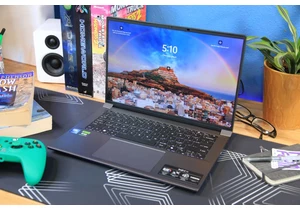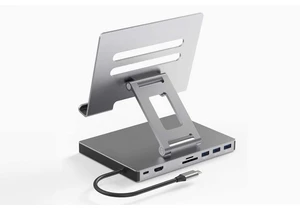I’m an Olympic gold-medal trash talker — on the level of the best NBA haters raining 280-character S*&T talk on X.com micro-seconds after your team’s tearful exit from the play-in (sniff, go Warriors).
Example: When I’d see a fellow journalist or analyst at a trade show sporting a laptop using Qualcomm’s previous Snapdragon 8cx Gen 3 running Windows, it was the perfect opportunity to do some class-A trash talking.
“I guess, you’re okay with Arm — because you must not do any work on your laptop.”
“I’m sure you need the extra battery life Arm-provides because everything is so much slower that you need more time to finish.”
Apple M1
In fact, my estimation of the expected performance of Apple’s M1 pre-launch was largely based on how well Arm-based chips have run Windows over the years — which is to say, horribly.
Once the M1 actually proved to be a worthy adversary (although not as much as its fanboys claimed it was) — I commented that “Apple should sue Qualcomm for giving all Arm-based laptops such a bad name.” See, I like to trash talk.
The thing is, with the hype-train leaving the station on Qualcomm’s Snapdragon X Elite — I actually have high hopes that the Snapdragon X Elite will finally, finally, run Windows without the slowdowns, hitches, and compatibility issues that have plagued Windows on Arm since the original Microsoft Surface RT (which, by the way, I actually kinda liked except for the fact that it didn’t run 99.8 percent of 2012-era Windows applications.)
Yes, I’m sure Arm fans think I’m the typical x86 fanboy extolling the decades-long reign of the superior x86 architecture that has defeated all others over the years.
Sun SPARC? Crushed by the lowly x86 chip that Sun magazine ads once lampooned as breakfast cereal toys. PowerPC? It was so stupidly hot in Apple’s Macs (and not very fast either), that it makes today’s stupidly hot 14th-gen Intel CPUs look like, well, an Apple M3 in power efficiency.
And how embarrassing was it for Apple, which once compared Intel’s x86 Pentium II to a snail in
There’s more on the hit list too: DEC Alpha? Maybe DEC Omega instead for being the last in the line. Motorola 68000? MOS 6502 and a serial-killer’s back yard full of other designs? All put into shallow graves by the inferior, “obsolete” x86 architecture loser tech companies and their fans have pissed and moaned about for decades.
Hell, x86 even managed to kill Intel’s own attempt to kill x86 in its failed Itanium IA-64 CPUs. Yes, even Intel couldn’t defeat x86 and it invented the bloody things.
The truth is that today, x86 dominates sales in everything from laptops to desktops, workstations, and supercomputers.
So, how the hell can I look forward to the Qualcomm Snapdragon X Elite actually being a good CPU and experience?
Competition, that’s why
Competition is good for everyone. In 2000, Transmeta’s very efficient, very overhyped — and very, very slow — VLIW-based Crusoe CPU helped push Intel to dust off its abandoned Pentium III design to compete in power efficiency as the Pentium M. Pentium M was the basis for the original Core CPU, which begat the Core 2 and Core i7 and is largely credited with saving Intel’s x86 lineup from the dead-end future of the dismal NetBurst / Pentium 4 and appropriately named “Pentium D” (what, Pentium F wasn’t available?). Yep, trash talk.
In fact, if it wasn’t for AMD’s innovations with x86-64 / AMD64 in 2003, the x86 world would likely be a very different one today perhaps not dominated by x86. And, by the way, AMD’s 4nm Ryzen mobile CPUs are wonderfully efficient and fast chips that often get ignored by Qualcomm and Apple — and they’re x86-based.
Wintel isn’t really a thing
And before you utter what you think is a gotcha: “Wintel” (the portmanteau of Windows and Intel), I’ll remind you that Microsoft Windows has supported over the years many of those dead architectures including DEC Alpha, IA-64, MIPS, and PowerPC. And despite the dismal failure of Surface RT (Arm-based Nvidia Tegra 3), Surface RT 2 (Arm-based Nvidia Tegra 4), and Surface Pro X (Arm-based Qualcomm SQ1), Microsoft obviously has continued to support Arm and is clearly the force pushing so hard for the Snapdragon X Elite to succeed.
Microsoft, you see, hasn’t favored x86 to the detriment of other architectures, it’s just that x86 has kicked so much ass for so damned long, that the only ones left standing today worth supporting with Windows are x86 and Arm (yes, RISC-V, we’ll see you in a PC when you get a Windows port).
So no, I don’t fear Qualcomm’s Snapdragon X Elite — and in fact welcome it into the fray, because it’ll either win and improve your Windows experience, or it’ll make x86 stronger and better, which will also benefit all of us.
May the best chip win.
https://www.pcworld.com/article/2314430/im-not-afraid-of-qualcomms-snapdragon-x-elite.html
Chcete-li přidat komentář, přihlaste se
Ostatní příspěvky v této skupině

Malware is just one way hackers and scammers can get you. Another com


Upgrading from Windows’ built-in antivirus tools can cost a pre

Earlier this year, Intel told the world that its next-gen Core Ultra

Keeping projects on time and under budget is a hard job, which is why

In the hybrid working world, you need solutions that will work for yo

Virtual machines, simulated PCs with their own operating systems runn
